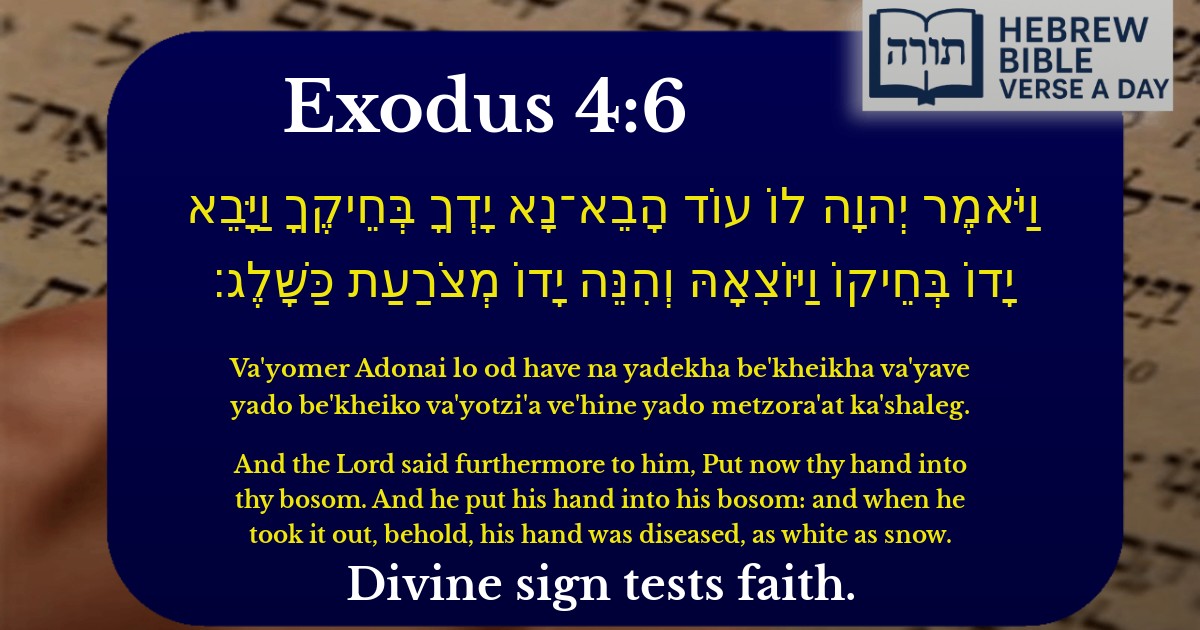Join Our Newsletter To Be Informed When New Videos Are Posted
Join the thousands of fellow Studends who rely on our videos to learn how to read the bible in Hebrew for free!
Hebrew Text
וַיֹּאמֶר יְהוָה לוֹ עוֹד הָבֵא־נָא יָדְךָ בְּחֵיקֶךָ וַיָּבֵא יָדוֹ בְּחֵיקוֹ וַיּוֹצִאָהּ וְהִנֵּה יָדוֹ מְצֹרַעַת כַּשָּׁלֶג׃
English Translation
And the Lord said furthermore to him, Put now thy hand into thy bosom. And he put his hand into his bosom: and when he took it out, behold, his hand was diseased, as white as snow.
Transliteration
Va'yomer Adonai lo od have na yadekha be'kheikha va'yave yado be'kheiko va'yotzi'a ve'hine yado metzora'at ka'shaleg.
Hebrew Leining Text
וַיֹּ֩אמֶר֩ יְהֹוָ֨ה ל֜וֹ ע֗וֹד הָֽבֵא־נָ֤א יָֽדְךָ֙ בְּחֵיקֶ֔ךָ וַיָּבֵ֥א יָד֖וֹ בְּחֵיק֑וֹ וַיּ֣וֹצִאָ֔הּ וְהִנֵּ֥ה יָד֖וֹ מְצֹרַ֥עַת כַּשָּֽׁלֶג׃
Parasha Commentary
📚 Talmud Citations
This verse is quoted in the Talmud.
The verse is referenced in a discussion about the nature of divine signs and miracles, particularly in the context of Moses' signs to Pharaoh.


Context in Shemot (Exodus) 4:6
This verse appears during Hashem's revelation to Moshe at the burning bush (Shemot 3-4), where Moshe expresses hesitation about leading Bnei Yisrael out of Mitzrayim. Hashem provides him with signs to demonstrate divine authority, including this miraculous transformation of his hand into a metzora (leprosy-like affliction) and back to health.
Symbolism of the Metzora Hand
Rashi (Shemot 4:6) explains that this sign served as a warning to Moshe for speaking negatively about Bnei Yisrael when he said, "They will not believe me" (Shemot 4:1). The affliction mirrored the punishment of tzara'at (often translated as leprosy), which the Torah associates with lashon hara (evil speech). The Maharal (Gur Aryeh) adds that the snow-like whiteness symbolized the purification process—just as snow cleanses, so too would Moshe's leadership purify the people.
The Bosom as a Symbol
The instruction to place his hand "in your bosom" (cheik) carries deeper meaning. Ramban (Shemot 4:6) notes that the cheik represents the heart—the seat of thought and speech. This physical act mirrored Moshe's internal doubt, and the affliction emerged from that place of hesitation. The Kli Yakar further connects this to the idea that spiritual ailments originate from within.
Practical Lessons from the Sign